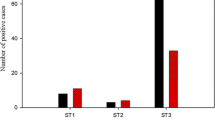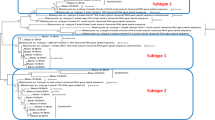Abstract
Blastocystis hominis is one of the most common eukaryotic organisms in the intestinal tract of humans, while its pathogenic potential is still controversial. A total of 286 stool samples obtained from adult and pediatric patients with or without gastrointestinal symptoms in two hospitals in Manisa, Turkey, were cultured to detect B. hominis infection. Forty-one and 51 isolates were obtained from the adults and children, respectively, and these isolates were subjected to subtyping by polymerase chain reaction (PCR) with the known sequence-tagged site primers. The correlation between the genotype and the symptoms was evaluated. PCR subtyping indicated that subtype 3 was the most common genotype in both symptomatic and asymptomatic groups, and the second common genotype was subtypes 1 and 2 in symptomatic and asymptomatic groups, respectively. A significant correlation between subtype 2 and the asymptomatic groups was found among both in pediatric and adult patients (χ 2 cal = 4.38, df = 1, p = 0.044). However, there were no significant differences between the other genotypes and the symptomatic or asymptomatic groups, as well as both the age and sex of the patients. The present study suggests that subtype 2 is a non-pathogenic genotype of B. hominis.
Similar content being viewed by others
References
Abe N, Wu Z, Yoshikawa H (2003a) Molecular characterization of Blastocystis isolates from birds by PCR with diagnostic primers and restriction fragment length polymorphism analysis of the small subunit ribosomal RNA gene. Parasitol Res 89:393–396
Abe N, Wu Z, Yoshikawa H (2003b) Molecular characterization of Blastocystis isolates from primates. Vet Parasitol 113:321–325
Abe N, Wu Z, Yoshikawa H (2003c) Zoonotic genotypes of Blastocystis hominis detected in cattle and pigs by PCR with diagnostic primers and restriction fragment length polymorphism analysis of the small subunit ribosomal RNA gene. Parasitol Res 90:124–128
Akdemir C, Helvacı R (2007) Evaluation of parasitological laboratory results of a group of people older than 15 years of age in Kutahya. Türk Parazitol Derg 31:37–40 (in Turkish)
Aksoy U, Akısu C, Bayram-Delibas S, Ozkoc S, Sahin S, Usluca S (2007) Demographic status and prevalence of intestinal parasitic infections in schoolchildren in Iznir in Turkey. Turk J Pediatr 49:278–282
Arisue N, Hashimoto T, Yoshikawa H (2003) Sequence heterogeneity of the small subunit RNA genes among Blastocystis isolates. Parasitology 126:1–9
Aykan B, Cağlar K, Kustimur S (2005) Evaluation of the protozoa found in fecal samples using the trichrome staining method. Türk Parazitol Derg 29:34–38 (in Turkish)
Böhm-Gloning B, Knobloch J, Walderich B (1997) Five subgroups of Blastocystis hominis from symptomatic and asymptomatic patients revealed by restriction site analysis of PCR-amplified 16S-like rDNA. Trop Med Int Health 2:771–778
Celik T, Daldal N, Karaman U, Aycan OM, Atambay M (2006) Incidence of intestinal parasites among primary school children in Malatya. Türk Parazitol Derg 30:35–38 (in Turkish)
Clark CG (1997) Extensive genetic diversity in Blastocystis hominis. Mol Biochem Parasitol 87:79–83
Culha G, Duran GG, Duran N, Canpolat A (2005) The distribution of intestinal parasites in students of the Mustafa Kemal University School of Health. Türk Parazitol Derg 29:258–260 (in Turkish)
Dagci H, Ustun S, Taner MS, Ersoz G, Karacasu F, Budak S (2002) Protozoon infections and intestinal permeability. Acta Trop 81:1–5
Dogruman-Al F, Hökelek M (2007) Is Blastocystis hominis an opportunist agent? Türk Parazitol Derg 31:28–36 (in Turkish)
Doyle PW, Helgason MM, Mathias RG, Proctor EM (1990) Epidemiology and pathogenicity of Blastocystis hominis. J Clin Microbiol 28:116–121
Hoevers J, Holman P, Logan K, Hommel M, Ashford R, Snowden K (2000) Restriction-fragment-length polymorphism analysis of small-subunit rRNA genes of Blastocystis hominis isolates from geographically diverse human hosts. Parasitol Res 86:57–61
Hussein EM, Hussein AM, Eida MM, Atwa MM (2008) Pathophysiological variability of different genotypes of human Blastocystis hominis Egyptian isolates in experimentally infected rats. Parasitol Res 102:853–860
Inceboz T, Üner A (2001) A study of the epidemiology of Blastocystis hominis. Türk Parazitol Derg 25:135–138 (in Turkish)
Kaneda Y, Horiki N, Cheng XJ, Fujita Y, Maruyama M, Tachibana H (2001) Ribodemes of Blastocystis hominis isolated in Japan. Am J Trop Med Hyg 65:393–396
Leelayoova S, Taamasri P, Rangsin R, Naaglor T, Thathaisong U, Mungthin M (2002) In vitro cultivation: a sensitive method for detecting Blastocystis hominis. Ann Trop Med Parasitol 96:803–807
Li LH, Zhou XN, Du ZW, Wang XZ, Wang LB, Jiang JY, Yoshikawa H, Steinmann P, Utzinger J, Wu Z, Chen JX, Chen SH, Zhang L (2007a) Molecular epidemiology of human Blastocystis in a village in Yunnan province, China. Parasitol Int 56:281–286
Li LH, Zhang XP, Lv S, Zhang L, Yoshikawa H, Wu Z, Steinmann P, Utzinger J, Tong XM, Chen SH, Zhou XN (2007b) Cross-sectional surveys and subtype classification of human Blastocystis isolates from four epidemiological settings in China. Parasitol Res 102:83–90
Ostan I, Kilimcioglu AA, Girginkardesler N, Özyurt BC, Ok UZ (2007) Health inequities; lower socioeconomic conditions and higher incidences of intestinal parasites. BMC Public Health 27:342
Özyurt M, Kurt Ö, Mølbak K, Nielsen HV, Haznedaroglu T, Stensvold CR (2008) Molecular epidemiology of Blastocystis infections in Turkey. Parasitol Int (in press)
Robinson GL (1968) Laboratory cultivation of some human parasitic amoebae. J Gen Microbiol 53:69–79
Stensvold CR, Brillowska-Dabrowska A, Nielsen HV, Arendrup MC (2006) Detection of Blastocystis hominis in unpreserved stool specimens by using polymerase chain reaction. J Parasitol 92:1081–1087
Stensvold CR, Suresh GK, Tan KSW, Thompson RCA, Traub RJ, Viscogliosi E, Yoshikawa H, Clark CG (2007a) Terminology for Blastocystis subtypes—a consensus. Trends Parasitol 23:93–96
Stensvold CR, Arendrup MC, Jespersgaard C, Mølbak K, Nielsen HV (2007b) Detecting Blastocystis using parasitologic and DNA-based methods: a comparative study. Diagn Microbiol Infect Dis 59:303–307
Stenzel DJ, Boreham PF (1996) Blastocystis hominis revisited. Clin Microbiol Rev 9:563–584
Tan KSW, Singh M, Yap EH (2002) Recent advances in Blastocystis hominis research: hot spots in terra incognita. Int J Parasitol 32:789–804
Termmathurapoj S, Leelayoova S, Aimpun P, Thathaisong U, Nimmanon T, Taamasri P, Mungthin M (2004) The usefulness of short-term in vitro cultivation for the detection and molecular study of Blastocystis hominis in stool specimens. Parasitol Res 93:445–447
Usluca S, Yalcın G, Over L, Tuncay S, Sahin S, Inceboz T, Aksoy U (2006) The distribution of intestinal parasites detected in the Dokuz Eylul University Medical Faculty Hospital between 2003 and 2004. Türk Parazitol Derg 30:308–312 (in Turkish)
Windsor JJ, Macfarlane L, Hughes-Thapa G, Jones SKA, Whiteside TM (2002) Incidence of Blastocystis hominis in faecal samples submitted for routine microbiological analysis. Br J Biomed Sci 59:154–157
Yan Y, Su S, Ye J, Lai R, Liao H, Ye J, Li X, Luo X, Chen G (2006) Genetic variability of Blastocystis hominis isolates in China. Parasitol Res 99:597–601
Yan Y, Su S, Ye J, Lai X, Lai R, Liao H, Chen G, Zhang R, Hou Z, Luo X (2007) Blastocystis sp. subtype 5: a possibly zoonotic genotype. Parasitol Res 101:1527–1532
Yazar S, Yaman O, Gözkenç N, Sahin I (2005) Distribution of intestinal parasites among patients who presented at the department of the Erciyes University Medical School. Türk Parazitol Derg 29:261–263 (in Turkish)
Yoshikawa H, Nagano I, Wu Z, Yap EH, Singh M, Takahashi Y (1998) Genomic polymorphism among Blastocystis hominis strains and development of subtype-specific diagnostic primers. Mol Cell Probes 12:153–159
Yoshikawa H, Abe N, Iwasawa M, Kitano S, Nagano I, Wu Z, Takahashi Y (2000) Genomic analysis of Blastocystis hominis strains isolated from two long-term health care facilities. J Clin Microbiol 38:1324–1330
Yoshikawa H, Wu ZL, Nagano I, Takahashi Y (2003a) Molecular comparative studies among Blastocystis isolates obtained from humans and animals. J Parasitol 89:585–594
Yoshikawa H, Abe N, Wu Z (2003b) Genomic polymorphism among Blastocystis isolates and development of PCR-based identification of zoonotic isolates. J Eukaryot Microbiol 50:710–711
Yoshikawa H, Morimoto K, Wu Z, Singh M, Hashimoto T (2004a) Problems in speciation in the genus Blastocystis. Trends Parasitol 20:251–255
Yoshikawa H, Wu Z, Kimata I, Iseki M, Ali IK, Hossain MB, Zaman V, Haque R, Takahashi Y (2004b) Polymerase chain reaction-based subtype classification among human Blastocystis hominis populations isolated from different countries. Parasitol Res 92:22–29
Yoshikawa H, Abe N, Wu Z (2004c) PCR-based identification of zoonotic isolates of Blastocystis from mammals and birds. Microbiology 150:1147–1151
Acknowledgment
A part of this study was supported by Grant-in-Aid for Scientific Research to H. Y. (B-17406007) and also was supported by The Scientific and Technological Research Council of Turkey (281-2245/2007).
Author information
Authors and Affiliations
Corresponding author
Rights and permissions
About this article
Cite this article
Dogruman-Al, F., Dagci, H., Yoshikawa, H. et al. A possible link between subtype 2 and asymptomatic infections of Blastocystis hominis . Parasitol Res 103, 685–689 (2008). https://doi.org/10.1007/s00436-008-1031-3
Received:
Accepted:
Published:
Issue Date:
DOI: https://doi.org/10.1007/s00436-008-1031-3




